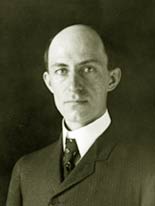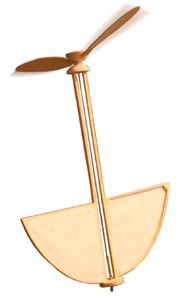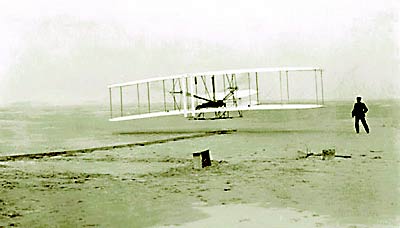
Wright Brothers
"the boys from Dayton"
Bishop Milton Wright and Susan Catharine Wright had four sons: Reuchlin, Lorin, Wilbur, and Orville, and one daughter Katharine. Wilbur, their third son, was born on a small farm near Millville, Indiana April 16, 1867, while Orville (1871-1948) and later Katharine were born at 7 Hawthorn Street in Dayton. Bishop Wright moved frequently from job to job, so the Wrights shifted houses frequently, though the house on 7 Hawthorn Street remained long in the family's possession. Milton Wright minister in the Church of the United Brethren in Christ, moved his family to Dayton in 1867 so he could edit the church newspaper published there.
 |
 |
Orville Wright |
Wilbur Wright |
 As youngsters, Wilbur and Orville looked to their mother for mechanical expertise and their father for intellectual challenge. Milton brought the boys various souvenirs and trinkets he found during his travels for the church. One such trinket, a toy helicopter-like top, sparked the boys' interest in flying. In school, Wilbur excelled, and would have graduated from high school if his family had not moved during his senior year. A skating accident and his mother's illness and subsequent death kept him from attending college. Orville was an average student, known for his mischievous behavior. He quit school before his senior year to start a printing business.
As youngsters, Wilbur and Orville looked to their mother for mechanical expertise and their father for intellectual challenge. Milton brought the boys various souvenirs and trinkets he found during his travels for the church. One such trinket, a toy helicopter-like top, sparked the boys' interest in flying. In school, Wilbur excelled, and would have graduated from high school if his family had not moved during his senior year. A skating accident and his mother's illness and subsequent death kept him from attending college. Orville was an average student, known for his mischievous behavior. He quit school before his senior year to start a printing business.
Orville wrote of his childhood: "We were lucky enough to grow up in an environment where there was always much encouragement to children to pursue intellectual interests; to investigate whatever aroused curiosity." The Wright household in Dayton had had two libraries: Books on theology were kept in the bishop's study, while the downstairs library had a large and diverse collection. Although Bishop Wright was a firm disciplinarian, both parents were loving and the family was a close one.
The Wright Cycle Co.
 The first time Wilbur and Orville referred to themselves as "The Wright Brothers" was when they started their own printing firm at the ages of 22 and 18. Using a damaged tombstone and buggy parts, they built a press and printed odd jobs as well as their own newspaper.
The first time Wilbur and Orville referred to themselves as "The Wright Brothers" was when they started their own printing firm at the ages of 22 and 18. Using a damaged tombstone and buggy parts, they built a press and printed odd jobs as well as their own newspaper.
In 1892, the brothers bought bicycles. They began repairing bicycles for friends, then started their own repair business. They opened up a bicycle shop in 1893, and three years later, made their own bicycles called Van Cleves and St. Clairs.
While nursing Orville, who was sick with typhoid in 1896, Wilbur read about the death of a famous German glider pilot. The news led him to take an interest in flying. On May 30, 1899, he wrote to the Smithsonian Institution for information on aeronautical research.
Within a few months after writing the Smithsonian, Wilbur read all he could find about flying. During this research he defined the basic elements of flying. Of all the early aviators, Wilbur alone recognized the need to control a flying machine in its 3 axes of motion: pitch, roll, and yaw. His solution: controlling wing shape during the flight with a process called 'wing warping.' He came up with the revolutionary system by twisting an empty bicycle tube box with the ends removed. Twisting the surface of each 'wing' changed its position in relation to oncoming wind. Such changes in position would result in changes in the direction of flight. Wilbur tested his theory using a small kite, and it worked.
Having designed a propeller with the same principles they used in their wing design, Wilbur and Orville then built their own 4-cylinder, 12-horsepower engine. They built the 1903 Flyer in sections in the back room of their cycle shop at 1127 West Third in Dayton.
When completed, the plane was shipped down to Kitty Hawk and assembled. On December 14, 1903, Wilbur won a coin toss and made the first attempt to fly the machine. He stalled it on take-off, causing some minor damage. The plane was repaired, and Orville made the next attempt on December 17. At 10:35 a.m., he made the first heavier-than-air, machine powered flight in the world. In a flight lasting only 12 seconds and covering just 120 feet, Orville did what men and women had only dreamed of doing for centuries . . . he flew.
Kitty Hawk, NC

Killdevil Hills looking south from the take-off location

First flight, 120 feet in 12 seconds, 10:35 a.m.; Kitty Hawk, North Carolina. The camera is looking northwest.
On Thursday, December 17, 1903, the historic day, it was Orville's turn to pilot. As Orville was riding the plane along the track made for a speed, the strong headwind allowed Wilbur to keep up easily, steadying the right wing as Orville had done 3 days earlier. Just after the Wright flyer lifted off the monorail, the famous picture was taken, possibly the most reproduced photograph ever, which Orville had set up (having asked one of the men simply to squeeze the shutter bulb after takeoff).
The Telegram

The telegram reproduced above was sent by Orville to his father in Dayton and subsequently to the world that that the first powered flight had occurred read:
176 C KA C8 33 Paid. Via Norfolk
Kitty Hawk, N C Dec 17
Bishop M. Wright
7 Hawthorne St
Success four flights thursday morning all against twenty one mile wind started from Level with engine power alone average speed through air thirty one miles longest 57 seconds inform Press home Christmas. Orevelle Wright

Orville and Wilbur Wright sitting on their front porch in Dayton.
Having satisfied themselves that powered flight was viable, the Wright Brothers returned to Dayton where they worked in perfected their flying machine. Working out of their bicycle shop, they conducted exhaustive research using a wind-tunnel they had designed and built, meticulously making notes on changes in their flyer.
After analyzing this research, they built another flyer and flew it from Huffman Prairie where they had made a make-shift air field. On October 5, 1905, they successfully flew their plane for over 39 minutes flying circles around the field. Controlled powered flight was now possible.
See video of a Wright Flyer III reproduction flying at Huffman Field >>





